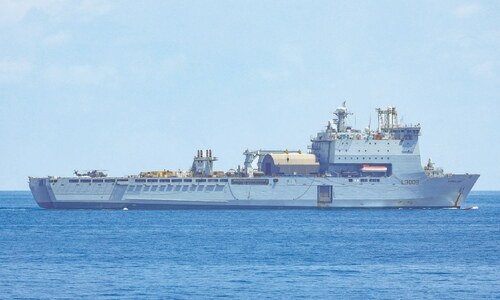WASHINGTON: The United States is gearing up to battle Russia and Europe for sales of billions of dollars in jet fighters, cargo aircraft and other arms to India.
US officials regard sales to India, with a potential $40 billion arms market including missile-defence systems, as a way to cement strategic ties and boost bilateral military cooperation as a hedge against China’s growing clout.
“By reaching out to India, we have made the bet that the planet’s future lies in pluralism, democracy and market economics,” said Nicholas Burns, the State Department’s No. 3 official, “rather than in intolerance, despotism and state planning,” an apparent reference to communist-ruled China.
“A significant Indian defence purchase from the United States ... would be a great leap forward and signal a real commitment to long-term military partnership,” he added in the November/December issue of the journal Foreign Affairs.
Burns, undersecretary of state for political affairs, cited as an example the 126 new multi-role fighter aircraft sought by the Indian air force, a potential $10.2 billion deal coveted by Washington as a key to stepped-up military ties.
Six fighter suppliers from Europe, Russia and the United States are to submit detailed bids by March 3. The US competitors, Lockheed Martin Corp and Boeing Co, are striving to unseat suppliers from Russia, India’s chief arms source during decades of Cold War US-Indian distrust.
Russia is offering its MiG-35 to replace the earlier-model MiGs the Indians now fly. Also in the race are France’s Dassault Rafale, Sweden’s Saab AB JAS-39 Gripen and the Eurofighter Typhoon, made by a consortium of British, German, Italian and Spanish companies.
Last week, Chicago-based Boeing agreed in principle to send as much as $1 billion in aerospace manufacturing work to India’s state-owned Hindustan Aeronautics Limited, or HAL, over the next 10 years.
Under a pact signed on Thursday in New Delhi, the mostly weapons-related work would start at $10 million to $20 million annually, “increasing in size and complexity as business opportunities develop,” a Boeing statement said.
UPHILL FIGHT TO SUPPLANT RUSSIA: Boeing hopes this may help meet what would be its need to produce goods worth half the fighter contract’s value if its F/A-18 Super Hornet strike aircraft wins over rivals.
But Boeing, the largest US exporter, struck the deal because it made good business sense and because it wants to be part of India’s aerospace industry, Jim Albaugh, president and chief executive of Boeing Integrated Defence Systems business unit, said in an email interview.
HAL’s projects for Boeing, Albaugh added, may include subsystems of the F/A-18, C-17 cargo aircraft, P-8 Multimission Maritime Aircraft and heavy-lift Chinook helicopters.
Bethesda, Maryland-based Lockheed, which is offering India its widely sold F-16 fighter, is close to a deal on six C-130J “Super Hercules” cargo planes valued at up to $1 billion. This would mark India’s biggest US military purchase so far.
Longer term, Lockheed says it is expecting opportunities to sell command and control systems, Patriot Advanced Capability-3 missile interceptors plus Hellfire and Longbow anti-tank guided missile systems, among other advanced weapons.
Earlier this month, a high-level US government working group cleared the way for Lockheed and Boeing — the Pentagon’s No. 1 and No. 2 suppliers by prime-contract value — to offer India cutting-edge radar technology as part of their fighter bids.
“The relationship has matured faster than many anticipated,” said retired Air Force Lt Gen Jeffrey Kohler, until August the Pentagon’s top arms-sale official and now an adviser to the private US-India Business Council.
Northrop Grumman Corp, General Dynamics Corp and Raytheon Co — the three next-largest US military contactors — all have announced moves of their own recently designed to tap into lucrative Indian markets.
But US companies face an uphill fight to supplant Russia, which has many manufacturing deals in place and deep ties to the Indian defence establishment.
Partly as a result of such tie-ins, “Washington will be extremely cautious about release of sensitive technology,” said Joel Johnson, an expert in international military trade at Teal Group, a Fairfax, Virginia consultancy.—Reuters
















































Dear visitor, the comments section is undergoing an overhaul and will return soon.